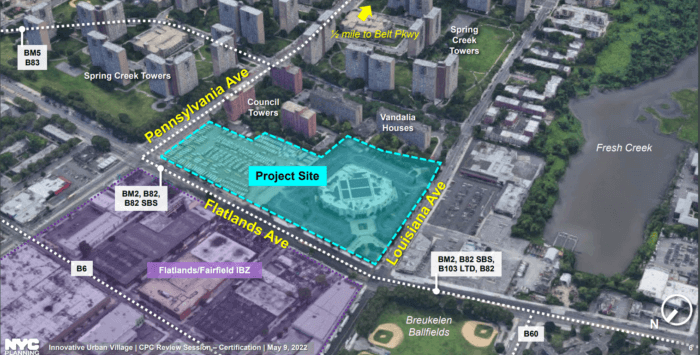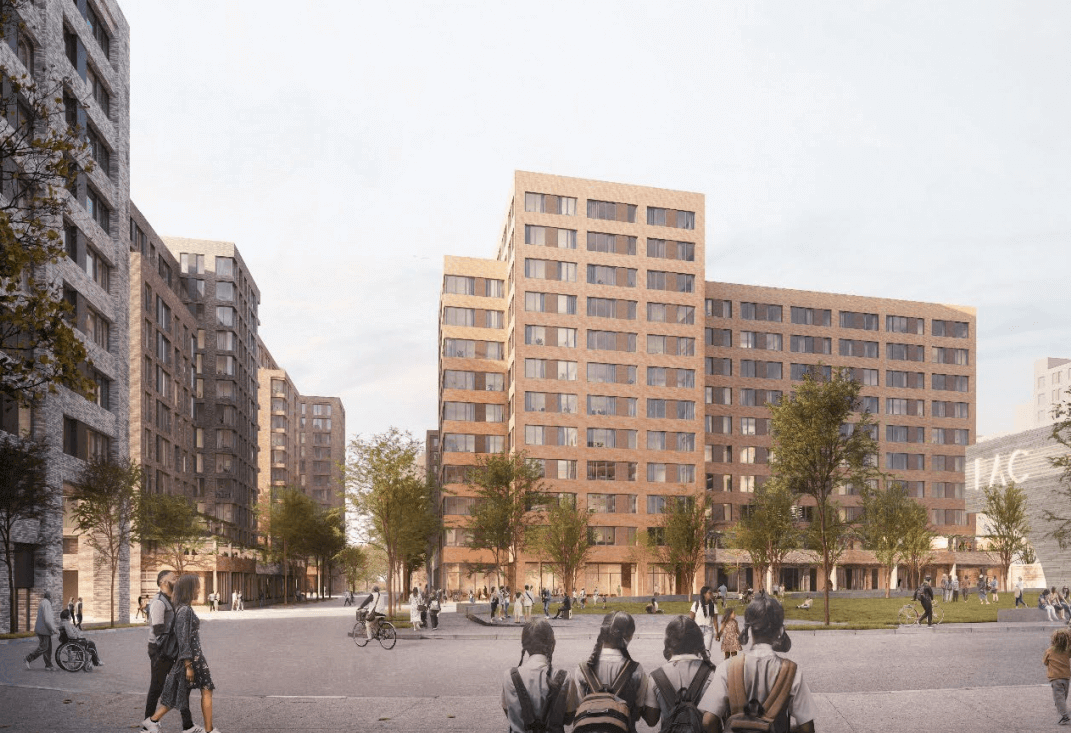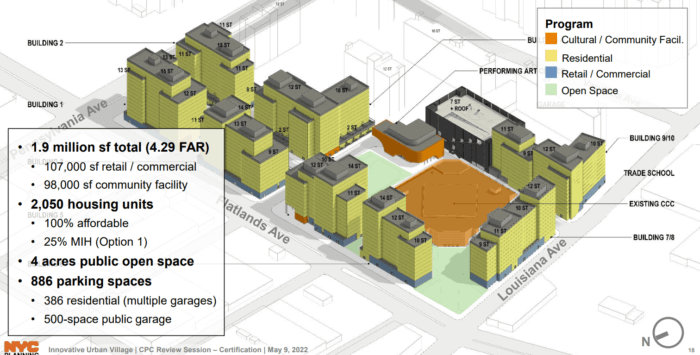Pastor's Proposed 'Urban Village' With Affordable Housing in East New York Begins Public Review
A Brooklyn megachurch pastor’s longtime vision of an “urban village” in East New York is approaching reality, with the Christian Cultural Center’s Innovative Urban Living plan now snaking its way through the city’s formal public review process.

A planned residential street in the Innovative Urban Living plan, dubbed the ‘urban village.’ Rendering by PAU via City Planning Commission
A Brooklyn megachurch pastor’s longtime vision of an “urban village” in East New York is approaching reality, with the Christian Cultural Center’s Innovative Urban Living plan now snaking its way through the city’s formal public review process.
The urban village would see 1.7 million square feet of new development in eleven buildings on the CCC’s 10.5 acre parcel at the northwestern tip of Starrett City, which adjoins the megachurch that, with 32,000 members, is one of the largest Christian parishes in the city. Developers hope to build 2,050 apartments, ground-floor retail including a grocery store, greenspace, a trade school, a performing arts center, and a daycare, along with 900 parking spots.
The project is a longtime dream of the Rev. A.R. Bernard, the owner and pastor at Christian Cultural Center. For decades he has hoped to develop the parcel he owns situated between his church and low-income senior housing operated by the Jewish Community Council, which currently serves as a depot for Total Transportation’s school buses.

In 2018 he partnered with the real estate developer Gotham to come up with a plan for an “urban village,” mixing affordable housing, retail, and public space, which he hopes will be a means to combat gentrification in the area.
After years of back-and-forth with community members and other stakeholders, the project entered the city’s Uniform Land Use Review Procedure last month after getting an initial review hearing at the City Planning Commission. The project is currently in a 60-day period for review by the local Community Board, CB5, which will last until mid-July before a vote can be cast.
The board has had several meetings with developer reps in the past few months where they discussed the project, said District Manager Melinda Perkins.
The developer’s plans call for half of the complex’s units to be reserved for the lowest-income potential tenants, those making between 30-60% of the area median income, about $36,000 to $72,000 for a family of three. The rest of the units would be divvied up for those making between 60-100% of AMI, about $72,000 to $120,000 for a family of three.
The apartments would be housed in eight residential buildings, ranging from 12-to-15 stories tall, shorter than many of the hulking tower blocks at nearby Starrett City.

Bernard and Gotham have somewhat scaled down the project’s dimensions after discussions with community stakeholders, according to the project’s Final Scope of Work. The new project contains fewer residential buildings and units with fewer floors, less retail space, and a smaller trade school, though the daycare and the public space will be slightly larger than originally planned.
“Over the course of the last five years we have had productive and informative meetings with community stakeholders to gather feedback and collaborate. Based on these meetings, we continue to refine the design, programming and housing plan,” Bernard said in a statement to Brooklyn Paper. “As a longtime community stakeholder, I am proud to be proposing a vision that provides our community with opportunities for a sustainable quality of life and economic mobility.”
Bernard, through a public relations rep, declined to be interviewed.
The biggest change to the plan is the parking: the developers more than doubled the planned amount of space for storing cars, from 170,000 to 343,000 square feet, including both below-ground parking and an above-ground parking garage. The site, and Starrett City in general, is relatively inaccessible by subway, with the L-train at East 105th Street nearly a mile away.

Though its backers see the project as a potential bulwark against gentrification, some worry it could be the opposite. The area’s former Councilmember Inez Barron told the New York Times in 2018 that she had concerns over the project’s affordability, positing that the units wouldn’t be affordable to residents of East New York, where the average income is much lower than the citywide average.
The local councilmember holds outsized sway over any development projects in their district requiring a rezoning, as the rest of the council typically defers to that member’s position, though that’s not always the case.
The Council seat has since changed hands, to Barron’s husband Charles, who had also held the seat before his wife and held the local Assembly seat in the interim. Barron did not respond to several requests for comment.
Editor’s note: A version of this story originally ran in Brooklyn Paper. Click here to see the original story.
Related Stories
- Public Scoping Meeting for East New York Affordable Mega-Development Set for March 3
- What Is ULURP? And Why Do We Have It?
- Community Land Trust Wants to Turn NYPD Parking Lots Into Affordable Housing. Can They?
Email tips@brownstoner.com with further comments, questions or tips. Follow Brownstoner on Twitter and Instagram, and like us on Facebook.





What's Your Take? Leave a Comment